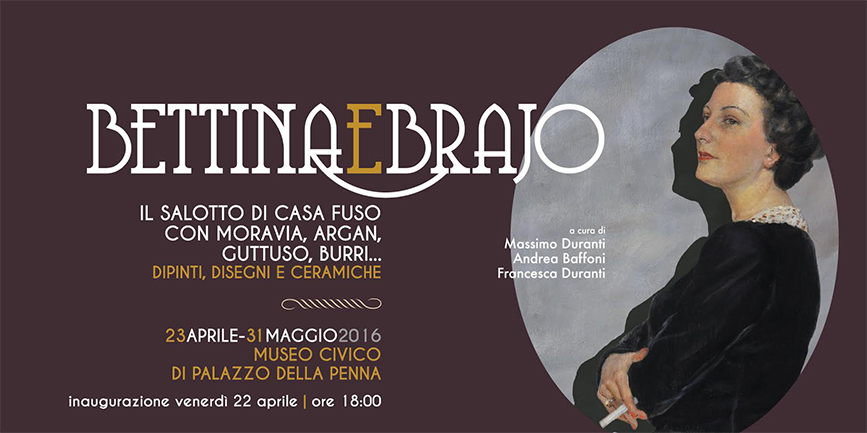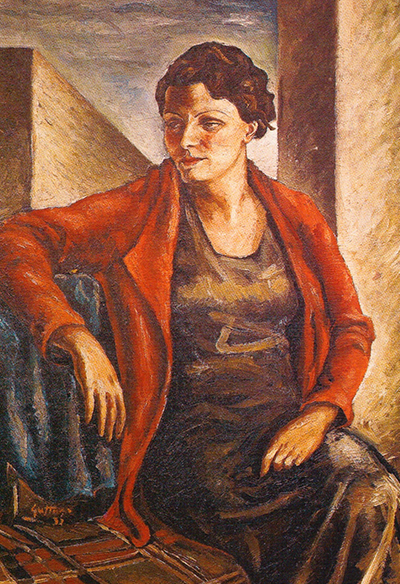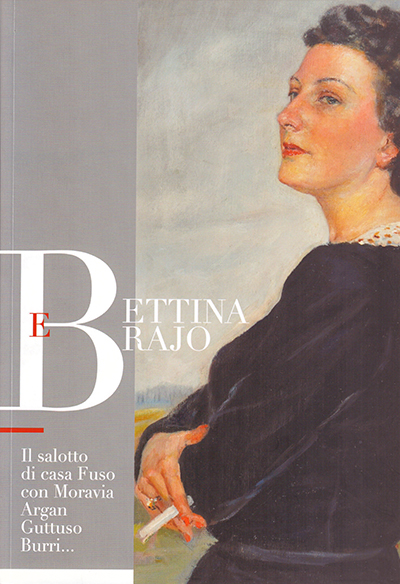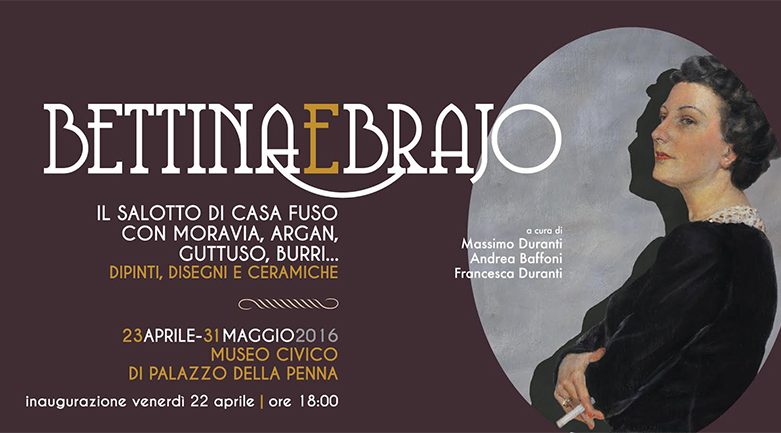
Bettina and Brajo, the art passed through the cultural gathering of the Fuso's house on display
The exhibition Bettina e Brajo, il salotto di casa Fuso, con Moravia, Argan, Guttuso, Burri… Dipinti, disegni e ceramiche, arranged in three locations (including the Civic Museum of Palazzo della Penna), illustrates the human and artistic history of Bettina and Brajo and their cultural gathering between the two wars and beyond. In the exhibition, there are the artworks of Bettina, a section dedicated to Brajo, and other artists related to them, among which: Renato Guttuso, Alberto Burri, Verdet, Tomea, Casorati, Costetti, Cascella, Pace and other Umbrian, De Felice, Bacosi, Arzilli, Dragoni, Raponi, Notari, Latella.
The curators of the exhibition are Massimo Duranti, Andrea Baffoni and Francesca Duranti.
We report below some statements in the aftermath of the exhibition opening.
Bettina: inspiring muse, the soul of the literary gathering, enthusiastic artist
“I was lucky to know the Fuseum, the beloved creation of Brajo Fuso, that brilliant and extroverted character from Perugia, vivid in all his expressions whether medical or artistic. In fact, he was a doctor and brilliantly graduated shortly after his return from the First World War. Equally rapidly, he specialised in odontostomatology; a few years later, he became a professor at the University in Rome, a brilliant and fast career. He also registered many patents for medical instruments and even medicines that have later been sold.
In the art world, his inspiring muse was Bettina, his beloved wife and lifelong companion. She attended the Accademia di Belle Arti and put brushes and paints in his hands while Brajo was recovering from wounds sustained during the Second World War.
She was also the soul of the famous literary gathering held as much at their residence in the heart of Perugia as at the Fuseum itself.
Thanks to her enthusiasm, Brajo became so passionate about art expressions that he dedicated every spare moment to the creation of new works. The Fuseum hosts a considerable number of them.
The Fuseum has been reopened for eight years thanks to the collaboration between Sodalizio di San Martino, the institution to which Brajo and Bettina donated the huge artistic complex, and the Fondazione Ecomuseo Colli del Tezio, appointed for its management and artistic direction.
The recovery and valorisation program of the park, the museum gallery and the artworks hosted inside has been long and complex and it has required a lot of care and attention from the Local Authorities of the Umbria Region and the Municipality of Perugia on the front line.
(Gianmaria Fontana di Sacculmino)

Bettina portrayed by Renato Guttuso

Cover of the catalogue of the exhibition
Among the turrets of Palazzo Cesaroni, a cross-section of the Perugian culture in the twentieth century
“The Legislative Assembly of the Umbria Region participates with interest in the exhibition "Bettina e Brajo: il salotto di casa Fuso con Moravia, Argan, Guttuso, Burri. The Assembly is not new to attending the presentation of important exhibition events of historical and artistic -nature (it is sufficient to remember Arte e patriottismo nell'Umbria del Risorgimento in 2011 – the great exhibition for the 150° anniversary of the Italian Unification) and even before other exhibiting initiatives like the one on ceramics.
The gatherings of the Fuso used to be held in Palazzo Cesaroni, the headquarter of this legislative institution. However, especially this exhibition is relevant because it represents a cross-section, substantially unpublished, of the culture of Perugia and Umbria in the ‘900s.
We have in our heritage two artworks by Bettina (the famous "roofs" that she saw from the loggia of the "turret" of this palace) and three artworks by Brajo. Also remembering that in 1981 an exhibition of the artworks by Bettina was held in this same building, it was thought to display them together with the exhibition of the Municipality of Perugia at Palazzo della Penna, with the aim of remembering the Fuso family and, indeed, the illustrious visitors of their gathering. Fundamental names in Italian literary and artistic culture active from the 1920s onward, such as Giulio Carlo Argan, Giuseppe Ungaretti, Gianna Manzini, Curzio Malaparte, Enrico Falqui, Massimo Binazzi; artists such as Renato Guttuso (their guest for months in 1932), Fiorenzo Tomea, Felice Casorati, Mario Mafai and then Alberto Burri, Gerardo Dottori; directors such as Massimo Bontempelli and Cesare Zavattini. Not forgetting that, before marrying Brajo, Bettina knew Alberto Moravia in Perugia, where she was writing her first novel. In cultural gatherings, they used to discuss literature and poetry, art and cinema: a cultural situation that the curators of this event have defined as sprovincializzazione (which can be explained as making a city less provincial) of a provincial city.
This event certainly wants to be a homage to Bettina Rampielli Fuso, a little more than thirty years after her death. She was an exceptional artist and woman of culture who managed with her kindness to interact and bring to Perugia very often the best of the Italian culture between two wars and beyond. The beautiful unpublished images of the Fuso and their friends overlooking the loggia of the "turret" displayed in our small exhibition are very significant. A special view of the rooftops of Perugia that Bettina knew how to portray in her paintings admirably, but not unoriginally - as critics say."
(Donatella Porzi)
A compensation to the backward step of a female artist
“From Camille Claudel and August Rodin to Frida Kahlo and Diego Rivera, from Gerda Taro and Robert Capa to Leonora Carrington and Marx Ernst, until “our” Perugian Zena Fettucciari and Arturo Checchi, the art history and not only figurative one, if we want to also include life and work partnership such as the one between Giulietta Masina and Federico Fellini or between Elsa Morante and Alberto Moravia, it is full of renowned couples. In this “painting”, to recall an image regarding the topic, the human and professional story of Bettina Rampielli and Brajo fits in perfectly. Two artists that, even with two different languages, have lived their love in total interpenetration with art, many times even entrusting to it the communication of their mutual feelings.
Fatally, however, in these couples, one of the two has achieved greater success than the other, almost always the male character, with the complicity of critics, the marketplace but, more often, a spirit of dedication that has historically caused women to retreat in favour of their life partner, sacrificing career to love, family, domestic balance.
This is a nice gesture, generous, spontaneous, sometimes even heroic, but the passing of time, at least in part, I think it is right to compensate for it, emphasising their professional role and the merit of their sacrifice even if postmortem.
It is a medal that, as a woman even before as an Assessor, I like to pin on the chest of Elisabetta Rampielli, an accomplished painter to whom, after 35 years from the monographic exhibition curated by Giorgio Bonomi, Perugia is dedicating an exhibition in the Civic Museum of Palazzo della Penna, precisely one of the spaces that in recent years has dedicated more than one initiative to his famous husband Brajo.
I owe to the perseverance of Massimo Duranti, tireless promoter of twentieth-century Perugian art and his group of young scholars, to the availability of the Sodalizio di San Martino, to the generosity of the heirs of the Rampielli-Fuso couple, Marcello Frenguelli and Adalgisa Matteucci, to the collaboration of the Regional Council of Umbria, to the kindness of Giammaria Fontana di Sacculmino and the Fondazione Ecomuseo Colli del Tezio the realisation of this exhibition, which I appreciate since it offers us not only the possibility of enhancing the work of an artist too little known to the public, but also represents a new opportunity to rediscover an important piece of the city life.
In fact, the exhibition proposes a broader reading than a monograph and reconstructs a cross-section of the local and national intellectual context in which the Rampielli-Fuso couple, or, in a gesture of affection toward our two illustrious fellow citizens, Bettina-Brajo, moved. Their homes, those in Perugia on the top floor of the Palazzo Cesaroni and then on Via Cacciatori delle Alpi, the Ansedonia villa and later the Fuseum, were the places of meetings with leading intellectuals and artists, from Guttuso to Giulio Carlo Argan, from Curzio Malaparte to Alberto Moravia, from Enrico Falqui to Little Tony and many others.
This is to highlight that Perugia in the past was far less provincial than what is believed in the globalization era.”
(Teresa Severini)





